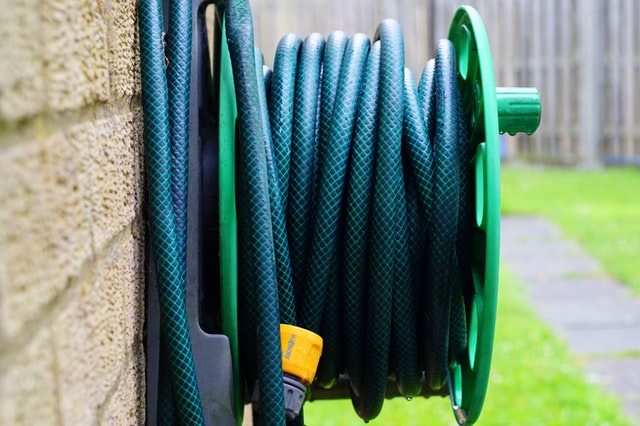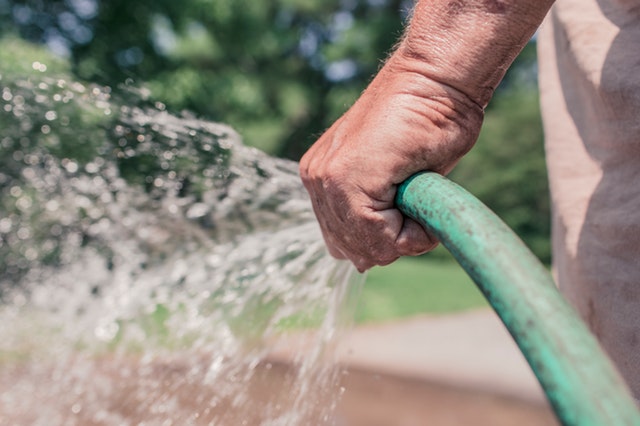
Depending on where you live, managing a dry lawn may be something you’re used to. But if you’re unsure of how to maintain a lawn in a dry climate, or when water is limited due to drought, then this is the guide for you. You can employ the following strategies to keep your lawn looking lush and fresh all year long.
Here are some techniques you can use to help your lawn grow better in arid conditions and survive periods without rain with minimal watering. Let’s dive in.
“When you water your lawn every morning, your’e training your yard to adapt to higher-than-normal presences of water. If this is the case, your yard can’t adjust to the arid weather and won’t grow deep roots into the soil.”
Don’t Water Your Yard Too Much or Too Little
We get it – when it’s hot and the days are long, it can be tempting to overwater your lawn to compensate for dryness or dormancy.
In reality, overwatering your lawn during dry spells and temporary droughts is one of the best ways to create future problems for yourself and your yard.
The same way humans can get addicted to sugar by overeating, the same can happen to grass with water.
Yes – water addiction is real in grass, and it can spell disaster for your lawn.
If you’re watering your grass too much and you live in a dry climate, you aren’t giving it a chance to adapt to its surroundings.
When you water your lawn every morning, you’re training your yard to adapt to higher-than-normal presences of water. If this is the case, your yard can’t adjust to the arid weather and won’t grow deep roots into the soil.
With regular watering, your grass will produce shallow roots that grow near the surface of the ground. The shallow roots will die quickly when your lawn doesn’t get its daily allotment of water, creating long-term issues for your yard.
Additionally, most of the water you’re giving your plants is evaporating before it absorbs into the soil. This is a complete waste of water for you and your lawn, and you can save money by using your sprinklers and hoses more efficiently.
When you limit the amount of water you give your grass, you will train it to adapt over time. By limiting how often you water, the blades will develop deeper root systems that are more effective at absorbing moisture from the soil.
Your grass can survive on much less water than you may think. Even species of grass like Kentucky bluegrass (famously known for their water-loving properties) can live with less moisture than most people believe.
We recommend watering your yard during the coolest parts of the day to minimize evaporation and maximize absorption.
If you water during the early morning hours before the high heat of the day, the water has time to sink into the soil, and your grass has a better chance of taking in the moisture.
It’s also essential to avoid watering when the wind kicks up. On windy days, evaporation will be faster than usual. If you water your yard on windy days, you may very well waste resources without benefiting your lawn.
Ideally, your lawn should need one good watering per week. If you water your lawn correctly and do so under the right conditions, you’ll get more out of one watering per week then shallow daily waterings.

Don’t Overly Stress Your Lawn During Droughts
Training your lawn to survive with less water is only one tactic in your arsenal against droughts and arid climates. By using other management techniques, you can give your lawn the strength it needs to survive dry spells.
It’s crucial to minimize your lawns stress during droughts and dry summer months.
It won’t surprise you to hear that many normal, daily activities can cause permanent damage to your lawn. Walking over the grass and mowing too often are common reasons a lawn looks less than ideal, even when they receive adequate water.
During periods with little rain, avoid major lawn care treatments of any kind. Fertilizing, seeding, or other activities are more likely to damage your lawn when it is dry and brittle. It is best to save these treatments for when moisture is present.
If you have pets, especially dogs, don’t let them play on your lawn during droughts. We know you love your pets, but they can seriously harm your yard during times with little rain. Consider taking them to a dog park to do their business and play instead of letting them do so on your lawn.
We don’t recommend mowing during temporary droughts or arid months until it is necessary. When less moisture is present in the soil, your yard will grow slower than usual. You won’t need to mow it as much for this reason alone.
Mowing your lawn while it is dry or dormant can cause permanent damage. It’s best to let your lawn be and minimize any treatments, mowing, or foot traffic to let it survive the drought without excessive stress.
Mow Your Lawn the Right Way
You’d be surprised at how many people mow their lawn too short. The general thought process is that cutting grass shorter means mowing less often.
It’s a reasonable thought but mowing your lawn too short is one of the worse things you can do during dry seasons and drought conditions.
As we discussed above, your grass is more susceptible to damage from stress during dry and arid conditions. It’s dryer, and the leaves are less resilient due to the lack of moisture. If you mow your lawn while your grass is in this condition, it can cause a spectrum of issues.
When you mow your lawn during drought conditions, don’t mow more than 1/3 of the average blade’s length. For example, if your lawn is about 3 inches high, mow no more than one inch off the top.
By mowing less, you’ll minimize the risk of fungal growth and poor soil conditions. When you mow too much of your grass, the long clippings can lay on the soil in block moisture from penetrating when it’s present. In times of drought, this can spell disaster for your grass.
If you mow the right sized clippings, they can significantly benefit your lawn during times of drought.
The clippings will serve as a mulch and fertilizer as they decompose and provide the soil with nutrients. The clippings may not be the most attractive feature of your lawn, but it’s worth leaving them there for their benefits.
It’s also important to keep your grass relatively tall during arid conditions. Taller grass provides shade for the soil, minimizing evaporation and promoting better moisture penetration. If you keep your grass at a healthy length, it can work wonders for its health and encourage better water absorption
Aerate Your Lawn
If you aren’t aerating your lawn, you’re missing out on one of the most effective ways to promote moisture penetration in the soil.
When your turf starts looking dry or brittle, water may have difficulty breaking through the surface of the soil to reach your lawn’s root systems. During droughts, these conditions are more common.
Aerating your lawn sounds complicated, but it’s a lot easier than it sounds.
Start by watering your lawn thoroughly for one or 2 days before you begin. We recommend applying at least one inch of water to your yard during this stage. It’s important that your lawn is moist before you begin aerating. The soft, moist soil will make it easier for your aeration device to break through the soil surface. This makes the process of aeration less challenging and physically exerting.
You don’t need an automatic core aerator to complete this process, but having one definitely helps. Many garden centers offer aerators for rent, but without experience, it may be a wiser investment to hire a professional lawn care team.
Most home improvement stores sell hand aerators that work well to aerate lawns. You need to wait until your lawn sheds the extra moisture from the pre aerating stage before you start the final step of the process.
Once you can press your hand aerator into the soil without any dirt sticking to the prongs when you remove it, your yard is ready to aerate. Your soil shouldn’t be powdery or fine, if inserting the hand aerator into the ground takes a lot of effort, moisten the soil more before you begin.
Use Proper Post-Drought Care
If you take care of your lawn the right way during a drought, you can minimize any damage it sustains into the next season. However, periods of extreme dryness and heat can be damaging to your yard even if you know how to keep grass green in hot weather.
After the dry season ends in your area, there are a few steps you can take to help your grass recover more quickly from the trauma of drought. Fortunately, most types of grass will recover on their own from even extreme damage. Grass is very resilient, and with proper care, can sustain in arid climates.
Once the drought ends, the first thing you should do is water your grass. This is especially true if you live in an area with water restrictions during droughts. You should try to water your grass as quickly as possible once your area allows free access to water again.
By watering your grass right after a drought, you can initiate root growth and stimulate a healthier lawn. If you live on top of a mountain or a hill where the wind is strong enough to hasten evaporation and dry out your lawn, watering post-drought is especially essential.
Once you’ve restored your lawns moisture levels, use a broadcast spreader to fertilize your lawn. We recommend using a 4-1-2 nitrogen to phosphorus to potassium ratio to give your grass the nutrients it needs. Note that this may vary depending on your local conditions and the type of grass in your lawn.
Be wary of high-nitrogen fertilizers – they can damage your grass if arid conditions return.
We also recommend killing weeds once your lawn starts to recover from a drought. Weeds will steal moisture from the soil and make conditions harder for your grass to thrive. Apply an herbicide to the weeds in your lawn (not the entire lawn), or pull them by hand. As you lawn grows lusher, there won’t be enough room for weeds to take hold.

Final Thoughts: How to Keep Grass Green in Hot Weather
As homeowners and lawn care professionals, we love our lawns. It can be hard to watch them struggle during the hot, dry months without knowing what to do.
Fortunately, there are a few ways to keep your lawn looking green and healthy even during times of drought. By incorporating the tips above into your summer lawn care schedule, you can maximize your yard’s health and prevent unsightly damage.
If your lawn has already suffered severe damage, it may be a wise investment to speak with a lawn care professional. It’s easier to prevent damage than to reverse it and using the wrong treatments may only further harm your lawn.